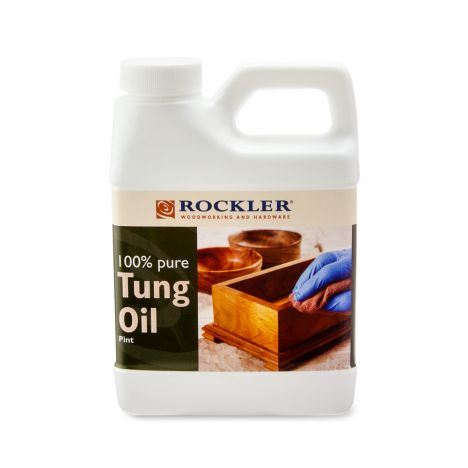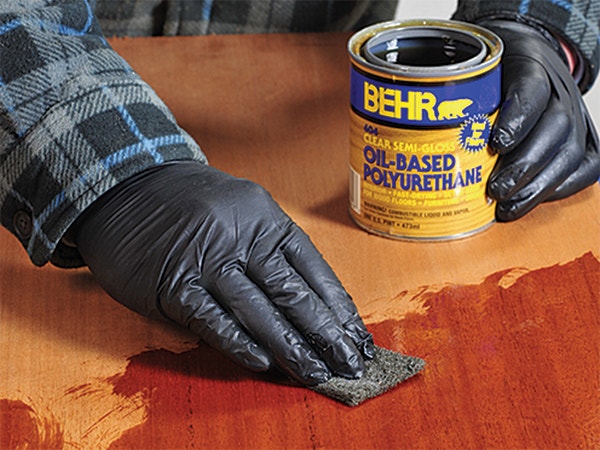Is Tung Oil the Best Choice for Finishing Plywood?
I have never been confident with finishing, thus have done little of it. I plan to make a freestanding shelf unit using maple plywood. I have chosen tung oil for the apparent simplicity of application. Is there a better choice you might recommend? - Ken Woodruff
Chris Marshall: Wipe-on finishes such as tung oil are very user-friendly, and they make the process of finishing vertical surfaces like yours more foolproof, too (harder to end up with drips if you wipe off the excess carefully). In terms of options for wiping finishes, however, I think tung oil dries slowly. You’ll also need to apply many coats of it to build the surface to a sheen that resembles other finishes like varnish, shellac or lacquer. So, if you haven’t bought that tung oil yet, let me suggest another option that is just as easy to apply but offers more durability in less time: Watco Danish Oil. Danish oil simply wipes on, and its varnish component forms a film on the wood surface for better protection. You can buy Danish oil without a tint added to it ("Natural") or in several wood stain colors.
Here's another "wiping" option that you might not even realize: ordinary oil-based polyurethane. Michael Dresdner suggests that unreduced oil-based poly can be scrubbed onto the wood surface with a fine nylon abrasive pad, then the excess wiped off. That will build to a tough, protective film even faster than Danish oil due to the higher concentration of varnish solids.

Tim Inman: You can do this! The first thing to do is think sports: You wouldn't think about going out on the playing field for a big game or tournament without first having practiced and practiced. You build your skills at practice time so when the big game comes, you're at the peak of your performance and you’re ready to win. You know the plays, you know the moves, you know the defenses. Finishing is a lot the same. Without first getting ready and practicing before you go out on the field game day, you’re doomed. Practice on scraps. Rehearse behind closed doors. Then go out with your new skills and artistic abilities and kick some butt! Be ready to win. You can do this!
I think selecting a simple finish like an oil for something like shelves is a good choice for you. It is an easier finish to do, with less pitfalls in the waiting, and you are more likely to win and be happy. I hope you'll be so happy you want to advance and move on to the more exquisite but more complicated finishes. Once you win a little, you'll want to go back and win a lot more. Fine wood finishing is one of the few places where you can join art, science and skill all together blended into a wonderful final product. Of course, I'm biased but….
I'm not trying to just be corny here. The willingness to practice to improve skills and artistic execution is important. Let me give you two examples to help prove my point. One is a trumpet player. When I was a boy, we lived with an uncle who had a son who was a big band leader. He was nationally known and at the top of his performance peak. We took care of his father, and occasionally the band leader would come home to visit Dad. What impressed me was that EVERY morning, this man would play scales and exercises on his trumpet. They were the same things every morning. Every morning! Even though this man could play in his sleep, and the tunes were like velvet coming out of that horn, he still practiced the basics EVERY morning. That impressed me, a teenage boy, a lot.
The second example is my son, Jon. Jon graduated top of his class in finishing school (wood finishing school, that is). He makes his living as a spot finisher and touchup artist. People, including his dad (me) are impressed with his skills. What isn’t seen by others is that Jon practices just like the trumpet player did. Every morning when Jon would come to work in my shop, he got out his junk cabinet doors and jabbed them up with a chisel – then practiced repairing the damage. He did this every morning he worked for me, and I think he still does it to this day. When people see him work, it looks so easy! Then when they try it themselves, they of course land on their noses. What he doesn't bother telling them, and he might be disappointed I'm telling you now, is that it doesn't come free. He practices. So, take a hint. Practice, practice, practice. Then people will start being amazed at how easy your skills make it look!
Keep the inspiration coming!
Subscribe to our newsletter for more woodworking tips and tricks





